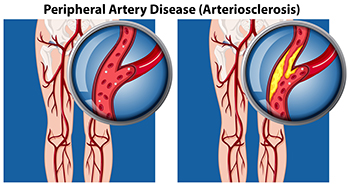
Peripheral artery disease, or PAD, manifests in various ways, often affecting the feet profoundly. Symptoms of PAD in the feet can include pain, cramping, or numbness, particularly during physical activity like walking or climbing stairs, which subsides with rest. In severe cases, individuals may experience non-healing wounds or ulcers on the feet or toes, indicating compromised blood flow. Several risk factors contribute to the development of PAD, including smoking, diabetes, high blood pressure, high cholesterol, and advancing age. Additionally, individuals with a sedentary lifestyle or those with a family history of cardiovascular disease are at increased risk. PAD occurs when arteries become narrowed or blocked due to the buildup of plaque, restricting blood flow to the limbs. Early detection and management of PAD are vital to prevent complications and improve outcomes. If you have symptoms of PAD in your feet, it is strongly suggested that you are under the care of a podiatrist who can help you find relief in addition to managing this condition.
Peripheral artery disease can pose a serious risk to your health. It can increase the risk of stroke and heart attack. If you have symptoms of peripheral artery disease, consult with Dr. Odin De Los Reyes from Connecticut. Our doctor will assess your condition and provide you with quality foot and ankle treatment.
Peripheral artery disease (PAD) is when arteries are constricted due to plaque (fatty deposits) build-up. This results in less blood flow to the legs and other extremities. The main cause of PAD is atherosclerosis, in which plaque builds up in the arteries.
Symptoms
Symptoms of PAD include:
- Claudication (leg pain from walking)
- Numbness in legs
- Decrease in growth of leg hair and toenails
- Paleness of the skin
- Erectile dysfunction
- Sores and wounds on legs and feet that won’t heal
- Coldness in one leg
It is important to note that a majority of individuals never show any symptoms of PAD.
Diagnosis
While PAD occurs in the legs and arteries, Podiatrists can diagnose PAD. Podiatrists utilize a test called an ankle-brachial index (ABI). An ABI test compares blood pressure in your arm to you ankle to see if any abnormality occurs. Ultrasound and imaging devices may also be used.
Treatment
Fortunately, lifestyle changes such as maintaining a healthy diet, exercising, managing cholesterol and blood sugar levels, and quitting smoking, can all treat PAD. Medications that prevent clots from occurring can be prescribed. Finally, in some cases, surgery may be recommended.
If you have any questions, please feel free to contact our offices located in Southbury and Farmington, CT . We offer the newest diagnostic and treatment technologies for all your foot care needs.
